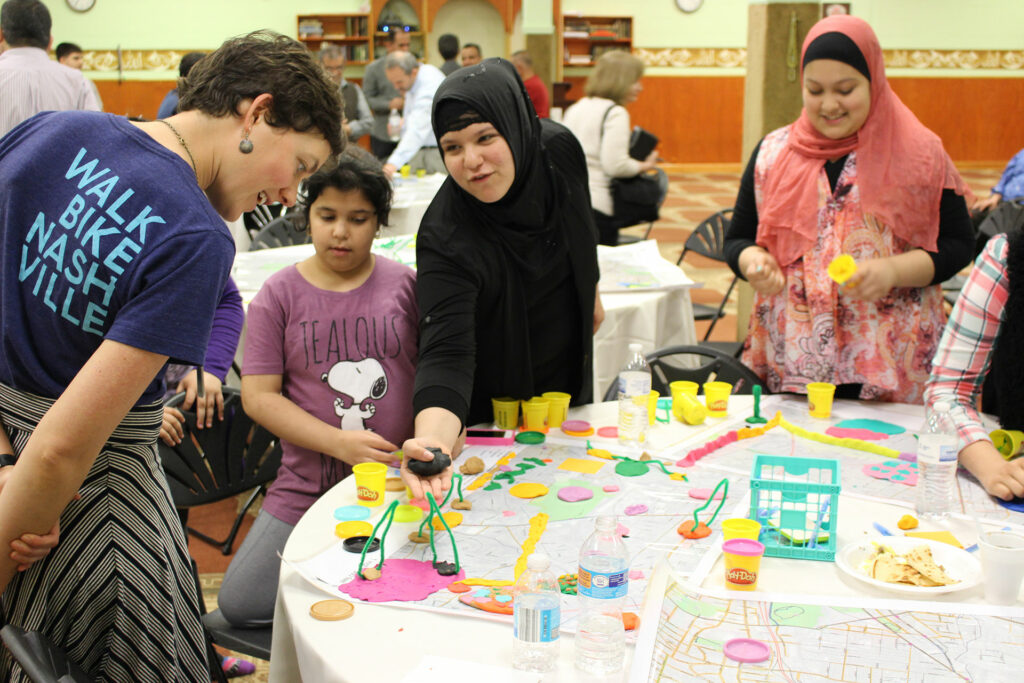
Finding and selecting an artist
You’re ready to engage an artist to work on your transportation project’s team. Where will you find an artist? And what type of artist should you look for? What skills do they need to have? We’ve explained some of the basics with regards to the different types of practices artists engage in, and some of the people who can help you find an artist below.
Types of artistic practice
We’ve explained the differences between creative placemaking, public art, percent for art ordinances, and art in transit programs; it’s important to also acknowledge that artists engage in a wide range of artistic practices that may or may not make them suited to working with you on a transportation project. Some relevant forms of artistic practice include the following:
- Studio practice: This usually refers to artists who create work in their studio alone or with a small team with the intention of exhibiting in a gallery setting.
- Public art practice: Public artists compete for commissions to create works of art for installation in public space. These works of art may be commissioned by cities, universities, developers, hospitals, states, or other entities with publicly accessible or viewable spaces. Public artists are likely to be well versed in community engagement, but will vary widely in their practice of creating work that is truly site and community specific versus specific to the vision of the artist and similar to past works created.
- Social practice: Artists with a social practice often create work outside the mainstream art market. For these artists, working with community members is essential to the work. In fact, the social interactions are the artwork.
- Civic practice: The Center for Performance and Civic Practice defines civic practice as involving “projects that bring artists into collaboration and co-design with community partners and local residents around a community-defined aspiration, challenge or vision.” This subset of social practice art is often led by civic institutions such as municipal agencies, neighborhood associations, or advocacy groups.
Visit MAPC’s Arts & Planning Toolkit for more information on social practice and civic practice.
In addition to these considerations related to artists’ practice, you’ll also want to think about the artist’s relationship to the community where you’re working. If you’re specifically looking for an artist to organize residents, or create a work of art that reflects local culture, it’ll be crucial for the artist to have a relationship with the local community or to possess the skills to build meaningful relationships with the community. While many artists are able to work with communities they are not part of, others are less skilled at this approach. It’s also important to remember that artists are everywhere—every community and every neighborhood in this country has artists, performers, and culture bearers who can be consulted and potentially hired as you begin your project.
Where can you find an artist?
Local arts agencies “promote, support, and develop the arts at the local level ensuring a vital presence for the arts throughout America’s communities,” according to Americans for the Arts. These agencies, which may have a wide range of names and may be set up as part of local government, a nonprofit, or a for profit corporation, are your best place to start your artist search. With more than 4,500 local arts agencies in the United States, chances are there’s an agency working in or near your community who can help you find an artist. More information about local arts agencies may be found on Americans for the Arts’ website and the National Endowment for the Arts’ Local Arts Agencies Fact Sheet.
Additional resources:
- Search for an arts organization, including Local Arts Agencies, on Americans for the Arts’ Arts Services Directory.
- Visit the Public Art Network’s Artist Selection Process Resource Guide for a step by step guide on creating a call for artists.
- Forecast Public Art’s sample budget template is a great starting point for your public art project budget.
Contracting with an artist
Once you’ve selected an artist, you’ll need to create and manage a budget for the project, and a contract and payment schedule for the artist. Smart Growth America routinely partners with municipal, regional, and state agencies, as well as other organizations, to help with artist selection, contracting, and project management. Contact our director of arts & culture, Ben Stone, at [email protected] to learn more about how we might be able to work together.
